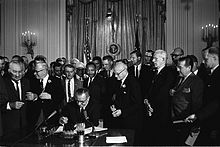- Older Americans Act
-
Older Americans Act of 1965 Long title: To provide assistance in the development of new or improved programs to help older persons through grants to the States for community planning and services and for training, through research, development, or training project grants, and to establish within the Department of Health, Education, and Welfare an operating agency to be designated as the ‘‘Administration on Aging’’. The Older Americans Act of 1965 (Pub.L. 89-73, 79 Stat. 218, July 14, 1965) was the first federal level initiative aimed at providing comprehensive services for older adults. It created the National Aging Network comprising the Administration on Aging on the federal level, State Units on Aging, and Area Agencies on Aging at the local level.[1] The network provides funding - based primarily on the percentage of an area's population 60 and older - for nutrition and supportive home and community-based services, disease prevention/health promotion services, elder rights programs, the National Family Caregiver Support Program, and the Native American Caregiver Support Program.[2]
In 2006 congress reauthorized the act in its entirety, effective through FY 2011.[3]
Contents
Overview
The OAA was passed as a part of Lyndon Johnson's Great Society reforms. It followed closely behind the Civil Rights Act and the Economic Opportunity Act which included many similarly structured programs, based around a centralized network of funding for a decentralized (community level) service delivery system. The OAA was a response to Congressional concerns about the lack of community social services for senior citizens.[3]
Funding for many Great Society programs as well as Johnson’s political capital, dwindled during the Vietnam War. Some programs and agencies were dismantled by later administrations, such as Nixon’s and Ford’s slow dissolution of the Office of Economic Opportunity. Other programs, such as those under the OAA, Medicare, Medicaid, and initiatives in the arts and humanities continue to survive.
The stated purpose of the OAA is to ensure equal opportunity to the fair and free enjoyment of: adequate income in retirement; the best possible physical and mental health services without regard to economic status; suitable housing; restorative and long term care; opportunity for employment; retirement in health, honor, and dignity; civic, cultural, educational and recreational participation and contribution; efficient community services; immediate benefit from proven research knowledge; freedom, independence, and the exercise of self determination; and protection against abuse neglect and exploitation.[4]
Structure
The act is divided into seven titles.
- Title I is a declaration of objectives.
- Title II establishes the Administration on Aging to carry out the provisions of the act.
- Title III provides federal funding for state agencies on aging. This title also mandates the creation of corresponding state agencies before states may be eligible for this funding.
- Title IV creates a number of specific projects related to the objectives of the act. These include healthcare service in rural areas, computer training, civic engagement, and Native American programs.
- Title V establishes a program for engaging low-income senior citizens in community service employment and volunteer opportunities.
- Title VI establishes grants for certain Native American-focused programs on aging.
- Title VII creates state grants for "vulnerable elder rights protection" programs.
Demographics
No one over age 60 can be denied services from OAA programs and in FY 2008 these initiatives provided services to nearly 3 million people, and for FY 2011 the federal appropriation for all programs is $1.9 billion.[5] A disproportionate amount of seniors receiving services (27%) are below the poverty line (compared to 9.7% of the general population over age 60).[5] Recipients of services under OAA are more likely to be female (71% vs. 57% of persons over 60). African Americans are over represented among OAA recipients and all other minorities are under represented. Recipients are also almost twice as likely to be rural, more likely to live alone, and on average have less income, less education, and are less healthy than those persons in the general population aged 60 and over.[6]
Programs created
- Administration on Aging (AoA) established under the Department of Health and Human Services as the federal level advocate for the aging population, and coordinator for service delivery to the elderly
- National Eldercare Locator Service a toll free hotline for identifying community resources
- Support Services to promote independence with regard to transportation, home care, legal aid, case management, and adult day care,
- Nutrition Programs including congregate and home delivered meals
- National Family Caregiver Support Program to provide respite services, education, training, and counseling to seniors providing kinship care, and to the caregivers of seniors
- Health Promotion providing educational services, counseling and consultation
- Aging and Disability Resource Centers to facilitate the dissemination of information on available resources
- The Community Service Senior Opportunities Act (OAA Title V) which works with the Department of Labor to provide employment opportunities for seniors
- Grants to Tribal Organizations
- The Long-term Care Ombudsman Program
- Elder Abuse, neglect, and exploitation public education services
See also
- Administration on Aging
- Age Discrimination in Employment Act of 1967
- Gerontology
- Great Society
- Social Security (United States)
- United States Senate Special Committee on Aging
References
- ^ Older Americans Act on Administration on Aging website, retrieved 7-7-2009
- ^ http://www.aoa.gov/AoARoot/AoA_Programs/OAA/Aging_Network/Index.aspx
- ^ a b Testimony in Senate Subcommittee hearing, May 2005.
- ^ http://www.aoa.gov/AOARoot/AoA_Programs/OAA/oaa_full.asp#_Toc153957785
- ^ a b http://www.nhpf.org/library/details.cfm/2626
- ^ http://www.aoa.gov/about/legbudg/current_budg/docs/AoAOnlinePerformanceAppendix012508Final.pdf
External links
- Full text of the act
- Historical Evolution of Program for Older Americans
- Transcript of House of Representatives committee hearings on the 2000 re-authorization of the act
- State Unit on Aging/Area Agency on Aging Finder
- Administration on Aging
- National Association of State Units on Aging
Categories:- United States elder law
- Ageism
Wikimedia Foundation. 2010.

